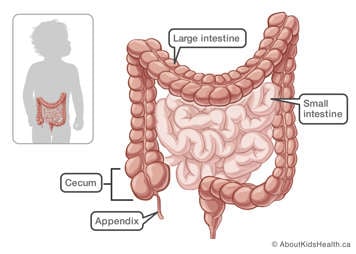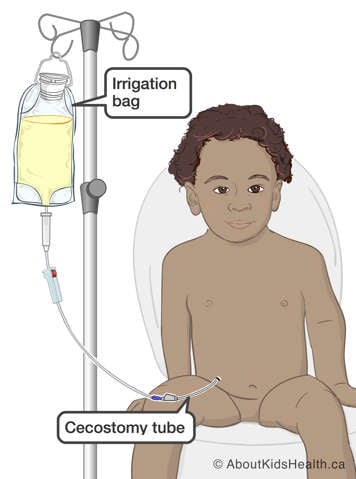What is a cecostomy tube?
A cecostomy tube (C-tube) is a thin plastic tube that is placed through the opening on the abdomen and directly into the cecum (first part of the large intestine). A cecostomy tube is inserted by an interventional radiologist using image guidance. A cecostomy tube is placed to help your child empty their bowel.

Who should receive a cecostomy tube?
C-tubes can help patients who have issues such as fecal incontinence (soiling) and severe constipation to be independent in their bowel management.

When a patient has a C-tube, the bowel is flushed out using an enema. Usually, an enema is given by placing liquid into the rectum to help empty the bowel. This is called a retrograde enema. But when using the C-tube, fluid is given through the tube, this fluid passes into the cecum and washes out the stool from above. This is called an antegrade enema. For an antegrade enema to be successful, it will require a lot of time and patience from the patient and their family. For this reason, getting a C-tube is not an option for all patients.
Your child may be a candidate for a C-tube if they:
- experience fecal incontinence with troublesome soiling.
- have experienced long-term severe constipation.
- do not respond well to rectal enemas or other constipation treatment.
Your child may not be a candidate for a C-tube if they:
- have had previous abdominal surgery.
- have excessive soft tissue between the skin surface and the cecum.
- are unable to sit for a prolonged period of time on the toilet.
Risks of a cecostomy tube insertion
C-tube insertion is a low-risk procedure. The risk may increase depending on your child's condition, age and health.
The risks of a C-tube insertion include:
- pain and discomfort
- bleeding
- infection of the skin, the abdomen or a generalized infection in the body. If your child has a VP shunt, there is a risk of shunt infection.
- granulation tissue—inflammation and extra tissue that forms around the C-tube
- bowel damage requiring surgery
Visiting the clinic before the procedure
Your child will have a clinic visit in the interventional radiology department before the procedure. This visit will usually take about two hours.
During the clinic visit you should expect:
- A health and nutrition history and a physical examination will be performed by a clinic nurse and registered dietician.
- An explanation of the procedure, and a review of the consent form.
- A review of fibre and fluid intake with a registered dietitian.
- Information on how to care for and use a C- tube with a clinic nurse.
- Information on transitioning to adult care from a pediatric institution to an adult facility, which begins at 16 years of age.
Giving consent before the procedure
Before the procedure, the interventional radiologist will go over how and why the procedure is done, as well as the potential benefits and risks. They will also discuss what will be done to reduce these risks and will help you weigh the benefits against the risks. It is important that you understand all the potential risks and benefits of the C-tube insertion and that all your questions are answered. If you agree to the procedure, you can give consent for treatment by signing the consent form. A parent or legal guardian must sign the consent form for young children. The procedure will not be done unless you give your consent.
How to prepare your child for the procedure
Before any treatment, it is important to talk to your child about what will happen. When talking to your child, use words they can understand. Let your child know that medicines will be given to make them feel comfortable during the procedure.
Children feel less anxious and scared when they know what to expect. Children also feel less worried when they see their parents are calm and supportive.
If your child becomes ill within two days before the procedure
It is important that your child is healthy on the day of the procedure. If your child starts to feel unwell or has a fever within two days before the C-tube insertion, let their health-care provider know. Your child's procedure may need to be rescheduled.
Food, drink, and medicines before the procedure
Your child’s health-care provider will tell you if your child will be required to clear their bowel beginning two days prior to the C-tube insertion. If required, the bowel is cleared in the following way:
- Two days before the procedure your child will start a clear fluid diet. They cannot have any solid food or milk during this time. Clear fluids include*:
- Chicken, beef or other clear broth (without noodles)
- clear apple juice
- sports drinks (e.g., Gatorade, Powerade)
- ginger ale
- flavoured drink mix (e.g., Kool-Aid)
- electrolyte replacement drinks (e.g., Pedialyte)
- popsicles
- water
*Fruit-flavored gels/jellies, like Jell-O, are not clear fluids and are not included. Your child will continue a clear fluid diet until after the procedure and until the health-care team tells you that it is okay for them to eat solid food. If your child has special needs during fasting, please talk to your referring health-care provider in advance. Your child may need to be admitted to the hospital for a bowel washout. - Your child will also need to take a bowel clearance medication called Pico-Salax to help clear their bowel before the procedure. Ask your referring health-care provider or a clinic nurse for instructions on how and when your child will need to take the medication.
- After your child has clear watery stool, they should continue drinking clear fluids. This is important to prevent dehydration. Your child can have clear fluids up to three hours prior to the scheduled procedure time.
- On the day of the procedure, please give your child their regular morning medicines with a sip of water.
- Medicines such as acetylsalicylic acid (ASA), naproxen or ibuprofen, warfarin or enoxaparin may increase the risk of bleeding. Do not give these to your child before the procedure unless they have been cleared first by their health-care provider and the interventional radiologist.
During the procedure
Arrive at the hospital two hours before the planned time of your child’s procedure. Once you are checked in, your child will be dressed in a hospital gown, weighed and assessed by a nurse. You will also have a chance to speak to the interventional radiologist who will be doing the C-tube insertion, and the anesthetist who will be giving your child medication to make them comfortable during the procedure.
During the procedure, you will be asked to wait in the surgical waiting room.
Your child will have medicine for pain
It is important that your child is as comfortable as possible for the procedure. Children will have a general anesthesia for C-tube insertion.
How is a cecostomy tube inserted?
At first, a temporary C-tube is inserted through your child’s abdomen, into the cecum. A small hole is made in your child’s abdomen (most of the time on the right lower abdomen). The temporary C-tube is then inserted using ultrasound and X-ray to guide it into the correct position in the cecum. The entire procedure takes 60 to 90 minutes. This temporary tube is straight with a curly end, like a pig’s tail, that keeps it in place. One or two small pieces of medical wire attached to a thread, called a retention suture, are used to hold the cecum close to the abdominal wall. This retention suture stays in for two weeks while the C-tube tract heals. The temporary tube will remain 3 to 4 inches outside of the body and is fastened to the skin with tape. A dressing will cover the insertion site for two weeks after the procedure. About six weeks after the temporary C-tube is inserted, it will be replaced with a long-term Chait trapdoor C-tube.

After the cecostomy tube insertion
Once the C-tube insertion is complete, your child will be moved to the recovery area. The interventional radiologist will come and talk to you about the details of the procedure. As soon as your child starts to wake up, a nurse will come and get you. Your child will be closely monitored and medication for pain will be given when needed.
Going home
Your child will stay in hospital for three to five days after they have had a C-tube inserted. Your child can go home when the health-care team feels it is safe for them to do so. Further teaching and instruction on how to use and care for the C-tube will be provided prior to your child's discharge home.
During the first two weeks after the procedure, your child should not go into the water, and they should avoid taking a bath or going swimming. After two weeks, the retention suture will be cut (this is a painless procedure), and the skin around the C-tube will be assessed. Further support will also be provided to you and your child.
About six weeks after the temporary C-tube is inserted, you will return to the interventional radiology department to have the tube replaced with a long-term Chait trapdoor C-tube. This tube is less visible than the temporary C-tube and lies almost flush to the skin. It takes only 15 to 30 minutes, and your child will not have to stay in hospital overnight or have a general anesthetic. These tubes are then changed yearly in the interventional radiology department.
Skin care
The C-tube that is first put in is temporary, and there will be a dressing over the insertion site. The C-tube will be secured to the abdomen with a device to prevent it from moving around in the tract. Your child will need to have a dressing covering the insertion site for two weeks until their follow-up appointment. The dressing will need to be changed at least once a day or whenever it gets wet, soiled or loose.
Flushing the temporary cecostomy tube
For the first 10 days, you will need to flush the temporary C-tube with 10 mL of normal saline twice a day to ensure the tube does not become blocked.
To make saline, you will need:
- one clean, air-tight glass bottle or jar with lid
- pot with lid
- water
- table salt (it is best to use non-iodized salt, which does not have iodine in it)
- baking soda (optional, but will make the solution less irritating)
Instructions
Option 1:
- Put 1 cup (250 mL) of tap water into a pot and boil for 15 minutes with the lid on.
- Remove from heat and cool until the water reaches room temperature.
- Add ½ teaspoon of salt into the pot and stir to dissolve. Optional: Add a pinch of baking soda and stir to dissolve.
- Carefully pour the salt-water solution from the pot into the jar or bottle and put the lid on.
- Refrigerate solution and use within 24 hours.
You can make larger volumes of this recipe to help save you time. Follow this recipe:
- Put 4 cups (1 L) of tap water into a pot and boil for 15 minutes with the lid on.
- Remove from heat and cool until the water reaches room temperature.
- Add 2 teaspoons of salt and 1 teaspoon of baking soda into the pot and stir to dissolve.
- Carefully pour the solution from the pot into the jar or bottle and put the lid on.
- Refrigerate solution and use within 24 hours.
Option 2:
You can used distilled water purchased from most pharmacies and grocery stores to make sterile and longer-lasting saline without boiling water. This is an easy and less time-consuming process.
- Mix 8 teaspoons of salt into 4 L of distilled water.
- Refrigerate solution and use within one month.
Bowel care
For the first 10 days after the C-tube insertion, your child should not use the C-tube for enemas and continue with their usual bowel cleansing routine as per their health-care provider's recommendations.
The C-tube site takes approximately 10 days to heal. Starting on day 11, your child will begin using the C-tube for regular bowel irrigations. During the first few weeks, you may need to adjust the time you do the bowel irrigations and how you do them.
For more details on how to care for your child after C-tube insertion, please see Cecostomy tube dressing and Cecostomy tube common problems.
At SickKids
If you have any questions or concerns about your child after they are discharged home, please call the Image Guided Therapy (IGT) clinic at (416) 813-7654 ext. 201804. Speak to the IGT clinic nurse during working hours or leave a non-urgent message.
If you have concerns and it is after working hours, see your child’s primary health-care provider or go to the nearest Emergency Department.
For more information on transitioning to adult care see the Transition to adult care Learning Hub.
For more information on preparing your child for their procedure see Coming for surgery.
